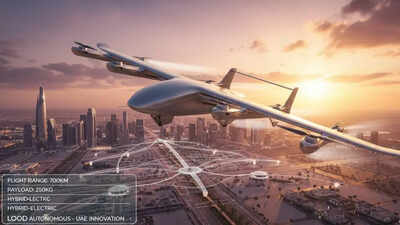The UAE announced a monumental breakthrough in global logistics this week, unveiling Heli, the nation’s first-ever hybrid autonomous cargo aircraft. Developed entirely by the Emirati company LOOD Autonomous and designed, developed, and manufactured fully within the UAE, the plane’s successful maiden flight was witnessed by Sheikh Zayed bin Mohammed bin Zayed Al Nahyan. This milestone immediately positions the country at the forefront of sustainable air transport innovation, marking the first time the region has produced a civilian heavy cargo aircraft capable of operating without traditional airports.
UAE first hybrid cargo plane launch
The UAE has done it again, rewriting the playbook for innovation in the skies. Meet Hili, the country’s first-ever hybrid cargo aircraft, a futuristic marvel designed to take off and land vertically like a helicopter but fly like an airplane. Launched in November 2025 under the supervision of the UAE Ministry of Economy and General Civil Aviation Authority (GCAA), Hili stands as a breakthrough moment for both Emirati aviation and the wider global logistics industry.Unlike traditional drones or planes, Hili combines electric and fuel power, offering both range and efficiency, a feat that could position the UAE as a pioneer in sustainable air freight technology. This hybrid cargo plane is designed for the “middle mile”, that crucial stage between warehouses and airports where speed, flexibility, and sustainability matter most. With a payload capacity of around 250 kilograms and a range of nearly 300 kilometres, Hili is set to change how goods, medical supplies, and parcels move across the Emirates.
Hili hybrid VTOL features and technology UAE
Built with a sleek, lightweight composite frame and powered by dual propulsion systems, Hili seamlessly switches between electric lift for vertical take-off and fuel-assisted flight for long-range cruising.Key features include:
- Hybrid VTOL system: Enables vertical take-off/landing without long runways.
- Smart flight controls: Integrated AI-assisted flight management system for stability and route efficiency.
- Extended range: Up to 300 km per flight, a benchmark for middle-mile operations.
- Payload versatility: Handles up to 250 kg, suitable for logistics, humanitarian aid, and emergency deliveries.
Developed in the UAE, Hili’s engineering has drawn attention from aviation authorities, cargo companies, and sustainability advocates worldwide. “Hybrid flight technology is no longer a vision — it’s an Emirati reality,” one senior GCAA official said during the unveiling ceremony.
Etihad Cargo partnership with Hili UAE
In a significant industry collaboration, Etihad Cargo has announced exploratory trials of Hili for regional logistics operations. The airline, which has already been testing advanced cargo drones, is expected to integrate hybrid aircraft into its Abu Dhabi–Dubai–Al Ain freight routes by 2026.The idea: to build air corridors for autonomous cargo movement that reduce travel time, bypass road congestion, and slash emissions. Etihad Cargo’s Chief Executive commented that “the hybrid cargo segment represents the next wave of supply chain disruption and the UAE will lead it.”This partnership underlines a broader vision: to make the Emirates a hub for advanced air mobility (AAM), not just for passengers, but for freight, logistics, and emergency operations.
UAE air mobility regulations
The government has already laid the groundwork for this airborne revolution.The GCAA and Abu Dhabi Department of Municipalities and Transport are finalising frameworks for hybrid heliports, vertiports, and air corridors designed for aircraft like Hili.In cities like Abu Dhabi and Dubai, these vertiports will double as take-off zones for both drones and eVTOLs, meaning the UAE could soon see a network of sky lanes dedicated to smart air logistics. Officials confirmed that regulations for hybrid cargo crafts are being finalised, ensuring airspace safety, emissions control, and integration with existing aviation systems. This multi-agency alignment, combining federal policy, private innovation, and local logistics is what sets the UAE apart as a model for aviation-driven economic transformation.
Innovation in aviation and sustainability
While Hili’s debut focuses on cargo logistics, experts say it’s just the beginning. The same hybrid VTOL technology could one day scale into passenger shuttles, air ambulances, or even floating emergency response platforms, all built under the UAE’s vision for sustainable sky mobility.Hili also aligns with the UAE’s Net Zero 2050 strategy, contributing to greener skies with lower fuel consumption, minimal runway dependence, and optimized routing. “This is about rewriting how we move things and eventually, people through the air,” said an Emirati aerospace engineer who worked on the project. “We’re not just designing aircraft. We’re designing the future.”With Hili’s unveiling, the UAE cements its position as a global leader in aviation innovation, joining a short list of nations actively testing hybrid air systems for real-world commercial use. From the first Mars Mission to the first hydrogen-powered trucks, and now the first hybrid cargo aircraft, the Emirates continues to redefine what’s possible in technology and transport.Industry insiders call it “the dawn of the hybrid air age,” and fittingly, it’s beginning in the UAE — a nation that never stops reaching higher. Go to Source




